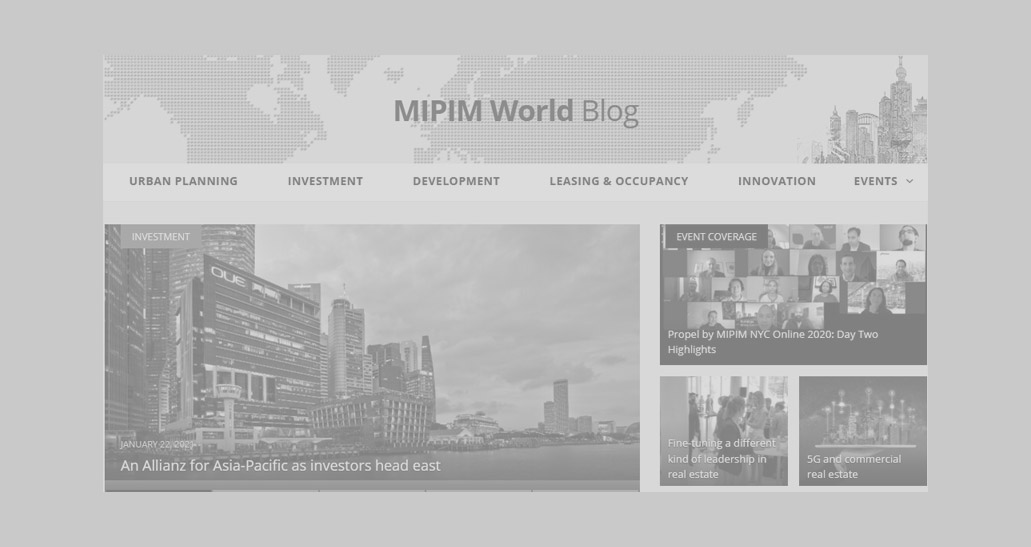July 22, 2020
Buildings That Take Care of People
As we transition to a new normal, how will our environments adapt to account for health and wellness of the occupiers?
The health and wellness of humans, and now buildings, is at the forefront of discussion as the world adapts to a “new normal” thanks to the impacts of COVID 19. As values and behaviors shift, so must our built environment.
The global wellness institute, believes wellness is a growing sector, currently valued at 5 trillion dollars, with wellness expenditures being more than half as large as total global health expenditures. These statistics clearly illustrate how strong the shift has been and the way that health and wellness are being prioritized.
The importance we place on our environment and our surroundings and the energies we gain from these spaces will continue to be a priority as we transition as a society. With this in mind, what effects will this have on real estate?
This MIPIM session with, Chantal Clavier, Partner at Heidrick & Struggles, James Ryan, Director – Asset Management at AA Projects, Mike Hood, Director of Development at U+I, and Ronen Journo, SVP at WeWork included conversations about the transitions the real estate industry, buildings and behaviors will go through as a result of a heightened emphasis on health, wellness and lifestyle. The panelists in this session discussed the accelerated efforts and measurements being put into place in our environments as a result of these new mindsets and behaviors.
Buildings that Take Care of People
“Once we get through this transition, it will be human centric. We will put the humans right at the center of any built environment.” – Ronen Journo
As the quality of these built environments improve, companies will be wiling to pay a higher premium for data driven environments that offer a better experience, safety, well being and overall ecosystem to the occupier.
“The assets that we do construct should be higher quality and focused on looking after their occupants.” – James Ryan
Delivering better Environments
There are a couple simple strategies that can be adopted to help buildings deliver better environments for the occupants including:
- Good Ventilation
- Lighting with Natural Lighting Preferred
“At the technical level, we’re going to see more and more technology that will connect the dots” – Ronen Journo
Data related to your environments systems, sensors, and acoustics, for example, will be readily available and accessible to occupants thanks to trends in technology and much cheaper sensors.
Buildings can now be rated on a WELL Building Standard, the leading global rating system and the first to be focused exclusively on the ways that buildings, and everything in them, can improve comfort, drive better choices and enhance health and wellness.
Creating a concept of community within our built environments will become important as people put more value on the time required to commute to work and the time they spend together in a business environment. “It’s got to be worth leaving the house.” – Mike Hood
Over the last few months as people work mostly from home, the realization that the behaviors that have been adopted for years are not actually required and working in an office for 40+ hours a week may not be necessary.
Change is coming
“At the very fundamental concept of demand and supply of real estate, I think we are going to see a degree of correction where the large occupiers will continue to accelerate their (space) optimization and once they do that, they will release space to secondary markets.” – Ronen Journo
It is to be expected that there will be a large number of sales or “disposals” of buildings that can no longer offer what are now considered basic requirements, like those that foster and promote wellness. Rather, leasing activity and occupancy will increase at buildings that can offer these amenities. In addition, there will be a refurbishment or redevelopment boom to bring standards up in existing buildings. Many competitive existing buildings will need to retrofit.
As we continue to move forward with humans at the center, behaviors, ideas and real estate will adapt. As companies try and navigate a new normal, many see this as a once in a lifetime opportunity to rethink how they do work and the environments they do it in.
Whitney graduated from the Master of Science in Real Estate (MSRE) program at the University of San Diego in May of 2018. She currently holds the role of Senior Director, Asset Services at Alexandria Real Estate Equities, a preeminent owner, operator and developer of collaborative life science, technology, and agtech campuses in the top urban innovation clusters in North America.



